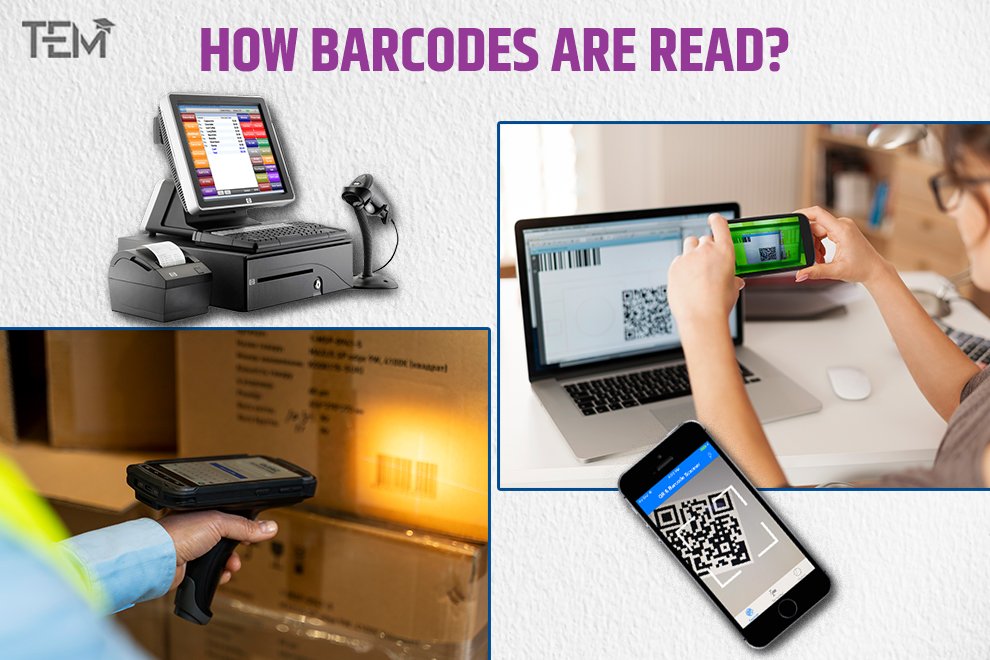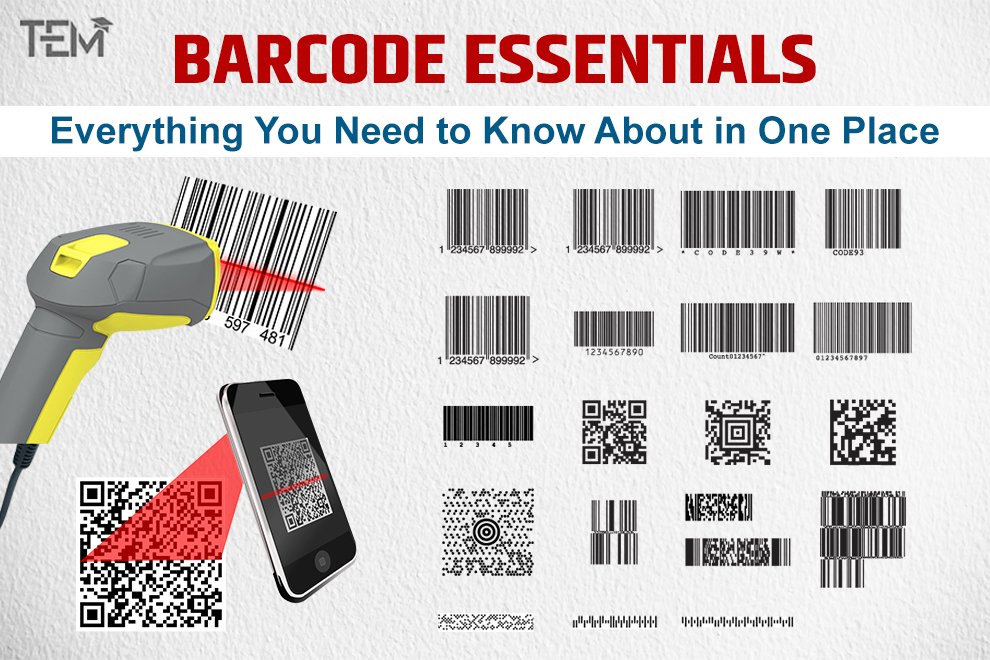Did you know that a pack of Wrigley’s chewing gum was the first item marked with a barcode, scanned in 1974?
Since then, companies and industries have incorporated them into our daily lives, from product labels to boarding passes to identity cards. They exist everywhere: on the products you buy, on the books you borrow, on the tickets you scan, and even on your smartphone.
But what exactly is it, and how does it work? How do people store and transmit information using it? In this blog post, we will answer all these questions and more.
We will explain what a barcode is, delve into its various types, explore the differences between barcodes and QR codes, discuss how they are generated and read, and highlight free platforms you can use to create and scan them.
What is a Barcode?
A way of representing data in a visual, machine-readable form is a barcode. A series of bars and spaces of varying widths or patterns that encode information such as numbers, letters, symbols, or images constitutes it.
Special devices called barcode readers can scan it. They use light or radio waves to decode the data and transmit it to a computer system. Various industries and applications, such as retail, logistics, healthcare, manufacturing, identification, and more, widely use them.
Norman Joseph Woodland and Bernard Silver invented the first barcode in 1952, based on Morse code technology.
They patented their invention in the US, but it took over 20 years before it became commercially successful.
The first item marked was a pack of Wrigley’s chewing gum, scanned at a supermarket in Ohio in 1974. Since then, it has evolved and diversified to meet different needs and standards.
Types of Barcode
There are many types of it, but they can be broadly classified into two categories: one-dimensional (1D) and two-dimensional (2D).
1D

1D barcodes are also known as linear barcodes because they consist of a single row of bars and spaces. They can only encode a limited amount of information, usually a number or a code.
Some examples of 1D barcodes are:
- Code 39: This is one of the oldest barcodes around and is a common symbology found in electronics, healthcare, and government. It is a lineal, 1D, alphanumeric code with the ability to include the entire 128 ASCII character set and extend to any length, only limited by the size of the label. If space is a concern, Code 128 would be a better choice to consider.
- Code 128: Derived from the ASCII 128 character set (0-9, a-z, A-Z, and some special characters), this compact barcode is used extensively in packaging and shipping applications worldwide. Code 128 features an automatic switching setting that allows users to optimize it for barcode length.
- Interleaved 2 of 5: Commonly found in warehouses, distribution, and manufacturing, Code I 2 of 5 is a numeric-only barcode used to encode pairs of numbers. Every two digits are paired to create one symbol. The number of digits used must be even for this format to work, so a zero is commonly added at the end of an odd set of numbers.
- Universal Product Codes (UPC): Found on nearly every retail product, these barcodes were originally created for grocery stores to provide quick receipt printing and inventory tracking. After securing a UPC number, a manufacturer will receive a unique company number to combine with their individual product numbers.
- International Article Number (EAN): Considered a superset of the UPC, these barcodes are used specifically by booksellers, libraries, universities, and wholesalers for book traceability. These 13-digit codes are created from the International Standard Book Numbers (ISBN) for each respective book tracked. Like UPCs, these are standardized for the unique identification of publishers.
2D

2D barcodes are also known as matrix codes because they consist of a matrix of dots, squares, hexagons, or other patterns. They can encode a large amount of information, such as text, images, URLs, or other data.
Some examples of 2D barcodes are:
- PDF417: This stacked, linear 2D barcode can be found in many types of identification such as your driver’s license. It is also the chosen standard by the USPS and Department of Homeland Security due to its advanced capabilities, such as encoding links to more than one data file.
- QR code: This is the most popular and widely used 2D barcode, especially for mobile applications. It is an arrangement of black and white squares that can store up to 4,296 alphanumeric characters or 2,953 bytes of data. It can be scanned by smartphones or tablets with a camera and a QR code reader app. It can be used to link to websites, social media, contact information, maps, and more.
- Data Matrix: This is a compact and versatile 2D barcode that can store up to 2,335 alphanumeric characters. It is composed of black and white cells arranged in a square or rectangular pattern. It can be read by most barcode scanners and mobile devices. It is used for small items, such as electronic components, or for applications that require high security and error correction.
Difference between Barcode and QR code

Barcode and QR codes are both methods of storing and transmitting data in a visual form, but they have some differences that make them suitable for different purposes.
Here are some of the main differences between barcode and QR code:
- A barcode is a 1D or 2D code, while a QR code is only a 2D code. It can be either linear or matrix, depending on the type. QR code is always a matrix code, composed of black and white squares.
- A barcode can store less information than a QR code. It can only store a limited number of characters, usually a number or a code. QR codes can store a large amount of data, such as text, images, URLs, or other data.
- It stores information horizontally, while QR code stores information horizontally and vertically. Barcode encodes data as a series of bars and spaces of varying widths or patterns. QR code encodes data as a matrix of black and white squares in both directions.
- A barcode requires a scanner, while a QR code can be scanned by a smartphone or tablet. A barcode needs a special device that can emit light or radio waves and read the reflected signals. QR code can be scanned by any device that has a camera and a QR code reader app.
- Barcode is used for product identification, inventory control, shipping, and more, while QR code is used for linking to websites, social media, contact information, maps, and more. It is mainly used for industrial and commercial purposes, such as tracking items, products, or shipments. QR code is mainly used for personal and mobile purposes, such as accessing information, sharing data, or making payments.
How Barcodes are Generated?
Generated by using software or online tools. A program that can create and print it with various formats, settings, and data is barcode software.
Web-based tools that can generate barcodes for free or for a fee are online generators. Both software and online generators require the user to input the data to be encoded, select the type, and adjust its size, color, and other options. The output is the image that can be saved, printed, or scanned.
Some examples of barcode software are:
- TEC-IT Barcode Software: This is a comprehensive software that can generate barcodes as part of applications or websites. It supports all 1D and 2D barcodes and can be used in C# .NET, VB .NET, Microsoft ASP.NET, ASP, PHP, Delphi, and other programming languages.
- Seagull Scientific BarTender: This is professional software that can design and print barcodes, labels, cards, RFID tags, and more. It supports over 100 symbologies and can be integrated with databases, spreadsheets, or other applications.
- Teklynx Label Matrix: This is a user-friendly barcode software that can create and print barcode labels, tags, tickets, and more. It supports over 100 symbologies and can be connected with Excel, Access, or other data sources.
Some examples of online barcode generators are:
- TEC-IT Online Barcode Generator
- Cognex Online Barcode Generator
- Barcodes Inc Online Barcode Generator
How Barcodes are Read?

The Universal Product Code (UPC) is like consisting of parallel bars and spaces that encode information through specific widths. During scanning, a sensor directs a beam of light over the barcode, reflects off it, and detects it.
The sensor sends an electrical signal to a decoder, which interprets and converts it into a digital code. There are laser and image scanners; the latter, though costlier, can read damaged barcodes.
Decoding involves recognizing patterns of black and white bars corresponding to numerical values. The decoder sends the digital code to a computer, which retrieves corresponding product details from a database, facilitating inventory and price tracking.
Error correction codes are often included to ensure readability despite damage. These codes add redundant information for error detection and correction.
They find applications in retail for inventory and pricing, logistics to track supply chain movement, healthcare for patients, medication, and equipment identification, and manufacturing to enhance efficiency and quality control. They revolutionize object tracking and are integral to our modern world, with their usage expected to expand further.
Free Platforms and their Links
Several free platforms are available for generating and reading barcodes. Some popular options include:
Conclusion
Barcodes revolutionized the way we manage information in the modern world. From inventory tracking to supply chain management, businesses of all sizes have found them to be an indispensable tool.
They have transformed industries and streamlined processes with their ability to encode and transmit data quickly and accurately. So, the next time you encounter those familiar black and white stripes, take a moment to appreciate the technological marvel that lies beneath their simplicity.
ALSO READ: 10 Soft Skills for Students for Personal and Professional Growth (First one is very important!)


